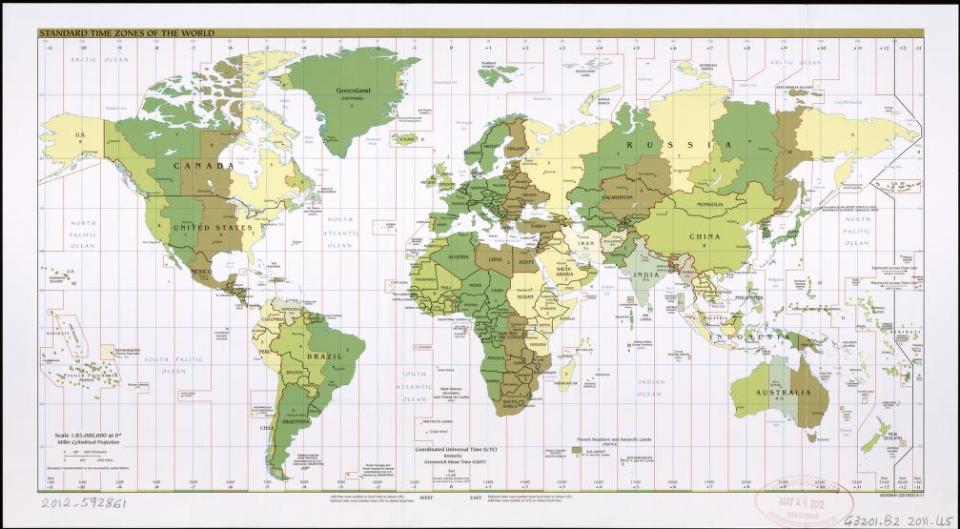What day is the winter solstice? It depends.

(WHTM) First, let’s get to the quick and easy answer to that question.
The winter solstice for 2023 will take place in our area on December 21 at 10:27 p.m. Eastern Standard Time. According to our abc27 Weather App, the sun will rise at 7:19 a.m. and set at 4:50 p.m., which works out to about 9 hours and 18 minutes of daylight.
OK, that’s us. What about the rest of the world?
Get daily news, weather, breaking news, and alerts straight to your inbox! Sign up for the abc27 newsletters here
We have 24 hours in a day, because why not? Among other advantages, 24 divides evenly into 360, which is the number of degrees in a circle, because again why not? Each of these 24 hours, then, would cover 15 degrees of longitude. This was all settled long before our time, so let’s not argue about it.
Time zone by time zone, another new year sweeps into view
As rapid travel became more of a thing, and accurate clocks became even more of a thing, it became more and more obvious establishing official time zones would be very useful. This was done in 1884, with the Prime Meridian, the line of Longitude that would be set at 0 degrees, established as the line that ran through the Greenwich Observatory in Greenwich, England. All other times would be expressed as so many hours ahead or behind Greenwich Mean Time (GMT).
Midstate Markers: The 40th parallel
This system essentially is the same today, though it was renamed Coordinated Universal Time (UTC) in 1972. (There was a lot more to the change, but that’s an online search for some other time.)

So, with 24 hours to cover, We begin at the Prime Meridian. Going westward, the offset is listed in negative numbers. If we go eastward the offset is listed as positive numbers (We’ll go west because it gets us to the continental United States faster.)
UTC-0 (+24) | Greenwich/London) | 3:27 a.m. | December 22 |
UTC-1 (+23) | Greenland | 2:27 a.m. | December 22 |
UTC-2 (+22) | Still Greenland | 1:27 a.m. | December 22 |
UTC-3 (+21) | Argentina, Parts of Brazil, Falkland Islands | 12:27 a.m. | December 22 |
UTC-4 (+20) | Canada – Atlantic Time Zone | 11:27 p.m. | December 21 |
UTC-5 (+19) | Eastern Standard Time/Harrisburg Time | 10:27 p.m. | December 21 |
UTC-6 (+18) | American Central Time Zone | 9:27 p.m. | December 21 |
UTC-7 (+17) | Mountain Time Zone | 8:27 p.m. | December 21 |
UTC-8 (+16) | Pacific Time Zone- Los Angeles | 7:27 p.m. | December 21 |
UTC-9 (+15) | Alaska Time Zone | 6:27 p.m. | December 21 |
UTC-10 (+14) | Hawaii/Aleutian Island Time Zone | 5:27 p.m. | December 21 |
UTC-11 (+13) | American Samoa | 4:27 p.m. | December 21 |
UTC-12 (+12) | United States Minor Outlying Islands | 3:27 p.m. | December 21 |
UTC-13 (+11) | New Caledonia, Solomons Islands | 2:27 p.m. | December 21 |
UTC-14 (+10) | Australia, Micronesia | 1:27 p.m. | December 21 |
UTC-15 (+9 ) | Japan, North and South Korea | 12:27 p.m. | December 21 |
UTC-16 (+8 ) | China, Western Australia, Indonesia | 11:27 a.m.. | December 22 |
UTC-17 (+7) | Thailand, Vietnam, Cambodia | 10:27 a.m. | December 22 |
UTC-18 (+6) | Bangladesh, Russia-Omsk Time | 9:27 a.m. | December 22 |
UTC-19 (+5) | Khazakstan, Russia Yakateringburg Time | 8:27 a.m. | December 22 |
UTC-20 (+4) | Russia – Samara Time | 7:27 a.m | December 22 |
UTC-21 (+3) | Moscow, Istanbul, Baghdad | 6:27 a.m | December 22 |
UTC-22 (+2) | Athens, Cairo, Jerusalem, Helsinki | 5:23 a.m. | December 22 |
UTC-23 (+1) | Berlin, Rome, Paris | 4:23 a.m | December 22 |
UTC-24 (+0) | Greenwich/London | 3:23 a.m. | December 22 |
So as you can see, the solstice happens one of two days, depending on where you are. The official arrival of winter happens around the world at exactly the same moment in every time zone, regardless of what the clock on the wall tells you. This is different from the New Year, which arrives in each time zone as it crosses the International Date Line in the Pacific Ocean. (The location of the IDL was selected because it was 180 degrees from Greenwich, and it’s mostly empty ocean.)
Of course, time zones aren’t as neat and tidy as this chart would suggest. Many of the lines zigzag to accommodate physical and political boundaries. Some locales adopt local times that are a half-hour or 45 minutes off the Coordinated Universal Time. But even those time zones build on UTC.
For the latest news, weather, sports, and streaming video, head to ABC27.

